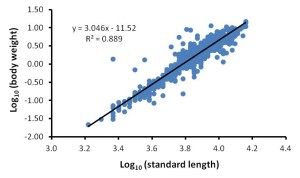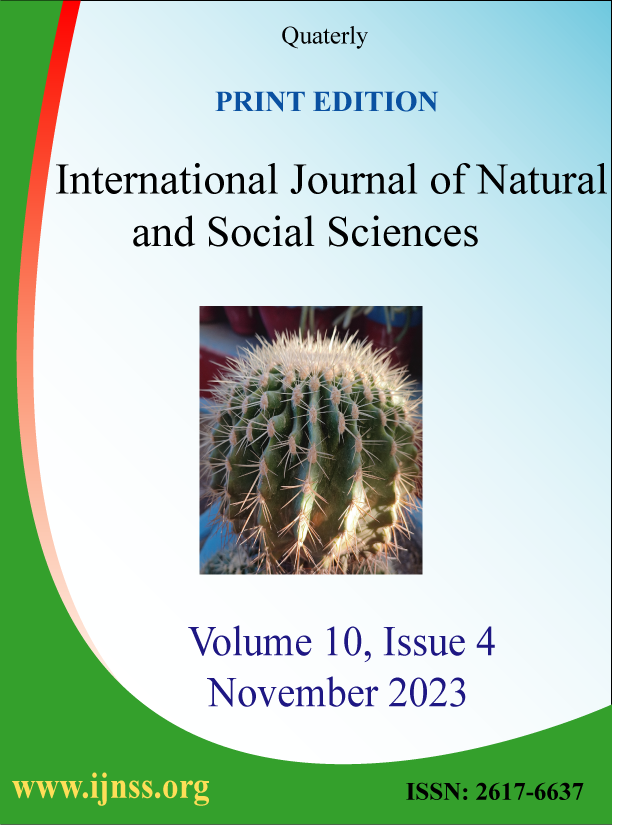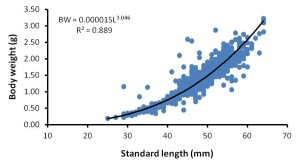Length-weight relationships and growth pattern of a danionin fish species Chela cachius (Hamilton, 1822) of a perennial lake in Bangladesh
Volume 2, Issue 3, May 2015, Pages 70–74
F Yeasmin, Z Faruque Ahmed![]()
![]() , M Gulshan Ara, M Sumon Mia and M Kaniz Fatema
, M Gulshan Ara, M Sumon Mia and M Kaniz Fatema
Department of Fisheries Management, Bangladesh Agricultural University, Mymensingh-2202, Bangladesh
| ABSTRACT | Get Full Text PDF |
The present research established monthly relationships between standard length and body weight with the construction of generalized relationships of pooled data over a calendar year, and monthly growth pattern of neon hatchet fish Chela cachius (Hamilton, 1822) (Cyprinidae: Danioninae) collected from a perennial lake in Bangladesh. Twelve monthly samples totaling 1200 specimens were used to conduct this study. The standard length and body weight ranged from 25 to 64 mm and from 0.19 to 3.22 g respectively. The parameter values of a and b of the cubic equation describing the relationships between standard length and body weight in the form of W = aLb varied monthly. The highest a value was calculated in September (0.00015), the lowest was in February (0.00001). The b value ranged between 2.15 to 3.20, which highest in February and lowest in September. The coefficient of determination (r2) ranged from 0.704 to 0.938. The results revealed that all length-weight relationships were highly correlated (r ≥ 0.839, P < 0.001). Confidence interval of b values at 95% confidence level revealed that growth pattern in February, June, October, November and December was isometric while growth pattern in other months was allometric. The generalized growth pattern of C. cachius population was isometric because the confidence limits of b value of the length-weight relationship at 95% of confidence level included 3 (2.98 – 3.11). The generalized length-weight relationships constructed for C. cachius was BW = 0.00001SL3.05 in the perennial lake under the study.
Key words: Chela cachius, length-weight relationship, growth pattern.
![]() Corresponding author.
Corresponding author.
E-mail address: zoarder2000@yahoo.com (ZF Ahmed)
How to cite this article: F Yeasmin, ZF Ahmed, MG Ara, MS Mia and MK Fatema (2015). Length-weight relationships and growth pattern of a danionin fish species Chela cachius (Hamilton, 1822) of a perennial lake in Bangladesh. International Journal of Natural and Social Sciences, 2(3): 70-74.
INTRODUCTION
Chela cachius, a danionin known as the neon hatchet fish, is one of the plainest members of the Chela genus under Danioninae sub-family. The fish is epibenthic, occurs in both freshwater and brackish waters in Bangladesh, India, Pakistan and Myanmar (Talwar and Jhingran 1991). Neon hatchet fish commonly inhabits rivers, ditches, ponds and lakes in plain and elevated regions (Menon 1999). The species gets itself established as population through reproduction thus becoming self-recruiting in ponds, tanks and small streams, and minimum population doubling time is less than 15 months (Musick, 1999). Small indigenous fish species (SIS) constitutes a major part of inland capture fisheries and C. cachius as SIS is almost an inevitable component of it. Proximate composition study revealed that the fish is a substantial source of essential macro- and micronutrients which plays an important role in the elimination of malnutrition in Bangladesh (Thilsted et al., 1997). Among many factors that results in gradual depletion of valuable fish stocks of various inland habitats in Bangladesh, lack of research providing information on fisheries biology of freshwater species as a tool for fisheries management is one of them (Santos et al., 1995). The neon hatchet fish is mostly available in small-scale inland subsistence fisheries, therefore, sustainable management and conservation of its numerous stocks across the country are of utmost necessary, and estimates of population parameters for the species are the bases of its fisheries management.
Length-weight relationships have been widely used for the conversion of growth-in-length equations to growth-in-weight for use in stock assessment models, to estimate stock biomass from limited sample sizes, as indicators of growth pattern, to compare the life histories of certain species between regions and other aspects of fish population dynamics (Kolher et al., 1995; Petrakis and Stergiou, 1995; Goncalves et al., 1997; Moutopoulos and Stergiou, 2002). Length-weight relationships are important for comparative growth studies (Moutopoulos and Stergiou, 2002). Isometric growth characterizes a fish having an unchanging body form and unchanging specific gravity. Many species follow this trait though allometry results in, and body shape is affected by time of year, stomach contents, spawning condition etc. In some cases, under allometry, the specific gravity of the fish may not be unity, and changes in the specific gravity of the flesh of fish have been shown to occur (Tester, 1940). In this study, we reported monthly length-weight relationships and growth types, and modeled the generalized length-weight relationship for a small indigenous fish species C. cachius collected from a perennial lake located in the campus of Bangladesh Agricultural University, Mymensingh, Bangladesh.
MATERIALS AND METHODS
Fish sampling
Fish was sampled from the large perennial lake by means of boats once in a month over a calendar year during daytime within 12:30 to 13:30 PM. The fishing gears included fine meshed cast and seine nets in order to ensure all size groups of the population available in the catch. At each sampling, emphasis was given on the fact that 100 fish specimens were collected. All specimens were preserved in 10% neutralized formalin in a small plastic container as soon as possible to avoid decomposition of fish.
Measurement of length and weight
Standard length was measured from the tip of the snout extended to the hind margin of the hypural bone of the tail usually located by the position of a crease when the tail was bent a little to the nearest mm with a measuring board. Body weight (BW) was weighed to the nearest 0.01 g with an electric digital balance.
Length-weight relationship and growth pattern
The relationship between body weight (BW) and standard length (SL) in fishes has the form: BW=aSLb, which after logarithmic transformation of both length and weight takes the allometric linear form: log10 BW = log10 a + b log10 SL (Huxley, 1932), wherein log10a is the intercept and b the slope of the equation. Confidence limits of both slope and intercept of linear equation at 95% confidence level were calculated on Microsoft Office Excel 2007. The monthly growth pattern of C. cachius population was assigned based on b value at 95% confidence level in the equation BW = aSLb. If the confidence limits of b value of length-weight relationship at 95% confidence level includes 3, the population growth pattern was isometric in a specific month, otherwise the growth is said to be allometric.
RESULTS AND DISCUSSION
A total of 1200 specimens from 12 samples were collected throughout the study period. The standard length and body weight ranged from 25 to 64 mm and from 0.19 to 3.22 g respectively. Two constants of logarithmic equivalent of length-weight relationships of monthly samples varied in this study. The highest log10a value ranged between -12.19 to -8.84. Exponential transformation of the intercept of logarithmic linear equivalent (log10a) of length-weight relationship equation in the form of W=aLb was derived highest in September, and it was 0.00015, the lowest value was calculated in February, and it was 0.00001. The other parameter of the power equation, b value among months also varied and it ranged from 2.15 to 3.20. The highest b value was estimated in February, and it was 3.20, the lowest b value was calculated in September, and it was 2.15. The coefficient of determination (r2) ranged from 0.704 to 0.938. The lowest and highest value of r2 was in August and February respectively. The study estimated high values of coefficient of determination in all months (r2 ≥ 0.704) which explained that the change of body weight was very high with the change of standard length in all months. The study estimated high value of correlation coefficient (r ≥ 0.839) as well in all months which indicated that there was a high degree of association between standard length and body. The values of parameters of power equations for monthly sample length-weight relationships, and their 95% confidence intervals for monthly populations of C. cachius are presented in Table 1. The study constructed the generalized length-weight relationships and its linear equivalent between standard length and body weight of this species using data pooled over the study period of entire calendar year, which is displayed in Figures 2 and 1. The intercept and slope of logarithmic equation were -11.52 and 3.05 respectively. The generalized cubic relationship between length and weight was BW = 0.00001SL3.05 with high values of correlation coefficient and coefficient of determination (0.943 and 0.889 respectively). Both correlation coefficient and coefficient of determination explained that there was a high degree of correlation between standard length and body weight and its positive value indicated that body weight increased with the increase of standard length, and the change of standard length was highly responsible for the variation of body weight. The confidence interval of b value of length-weight relationship equation at 95% confidence level determined the population growth pattern at each month. Since the confidence interval of b values at 95% confidence level in February, June, October, November and December included 3, therefore, growth of the C. cachius population of those months were isometric. On the other hand, growth type in remaining months was allometric on account of excluding 3 from 95% confidence intervals of b values (Table 1). The generalized growth pattern of C. cachius population was isometric because the confidence limits of b value of the length-weight relationship at 95% of confidence level included 3 (2.98 – 3.11).
Table 1
Parameters of monthly length-weight relationships in the form of W = aLb and growth pattern for C. cachius collected from the perennial lake over the study period.
| Month | Fish No | a | SEa*t | b | SEb*t | r2 | GP |
| Jan | 100 | 0.00004 | 0.00002 | 2.61 | 0.231 | 0.837 | Allometric |
| Feb | 100 | 0.00001 | 0.00000 | 3.20 | 0.165 | 0.938 | Isometric |
| Mar | 100 | 0.00003 | 0.00002 | 2.75 | 0.226 | 0.856 | Allometric |
| Apr | 100 | 0.00013 | 0.00009 | 2.42 | 0.271 | 0.763 | Allometric |
| May | 100 | 0.00003 | 0.00068 | 2.45 | 0.431 | 0.850 | Allometric |
| Jun | 100 | 0.00001 | 0.00001 | 2.94 | 0.173 | 0.921 | Isometric |
| Jul | 100 | 0.00006 | 0.00179 | 2.63 | 0.309 | 0.772 | Allometric |
| Aug | 100 | 0.00010 | 0.00007 | 2.46 | 0.321 | 0.704 | Allometric |
| Sep | 100 | 0.00015 | 0.00023 | 2.15 | 0.301 | 0.873 | Allometric |
| Oct | 100 | 0.00002 | 0.00001 | 2.91 | 0.234 | 0.862 | Isometric |
| Nov | 100 | 0.00002 | 0.00001 | 2.90 | 0.167 | 0.924 | Isometric |
| Dec | 100 | 0.00002 | 0.00001 | 2.90 | 0.181 | 0.911 | Isometric |
SE, standard error; t, values from t table; GP, growth pattern

Figure 1
Double logarithmic relationship between standard length and body weight using pooled data over the study period.
Figure 2
Generalized relationship between standard length and body weight of C. cachius using pooled data over the study period.
FishBase contained 8,049 records for length-weight relationships for 3,164 species of fishes as an important component of it (Froese and Pauly, 2000). Froese (2006) established that the values of the slope b generally range between 2 and 4, with 90% of the values ranging from 2.7 to 3.4 based on the analysis of a large number of length-weight relationships from FishBase. The monthly b values of C. cachius assumed similar trend of those species recorded in Fishbase. Both the parameters of length-weight relationship equations varied monthly in particular in the present study. The parameters a and b of length-weight relationship vary with the size range of the sample, sex, season and area (Bagenal and Tesch, 1978; Safran, 1992; Froese, 2006). In an extensive work on the length-length, length-weight relationships and condition factor of same species collected from the river Old Brahmaputra, Ahmed et al., (2012) found similar results in their study. Biologists seem to understand isometric growth as constant proportion with respect to body size and allometric growth as varied proportion with respect to body size of organs and limbs. The mature form of animals is the ultimate consequence of isometric growth of some tissues and allometric growth of other tissues (Gould 1966). Values of b smaller, equal and larger than 3 indicate isometry, negative allometry and positive allometry respectively (Carlander, 1977; Froese, 2006). The growth pattern that were assigned to the monthly populations for this species varied, a phenomenon that was also apparent in the study of Ahmed et al., (2012) on neon hatchet fish C. cachius.
CONCLUSION
Length-weight relationships are often used in fisheries and ecological research because growth-in-length equations are required to convert to growth-in-weight for stock assessment purposes. They are used for the estimation of the biomass of a species from length frequency data from both surveys on research vessels and underwater investigations. Length-weight relationships predict growth pattern and the condition of fish, and are used to compare life histories of a certain species between-regions. This is the first work on size relationships and growth pattern of C. cachius collected from an inland closed water body which is the common habitat of the numerous stocks of this species across Bangladesh.
REFERENCES
Ahmed ZF, Hossain MY and Ohtomi J (2012). Condition, length-weight and length-length relationships of the silver hatchet Chela, Chela cachius (Hamilton, 1822) in the Old Brahmaputra River of Bangladesh, Journal of Freshwater Ecology, 27 (1): 123-130
Bagenal TB and Tesch FW (1978). Age and growth. In: Methods for assessment of fish production in fresh waters, 3rd edn. T. Begenal (Ed.). IBP Handbook No. 3, Blackwell Science Publications, Oxford, pp. 101-136.
Carlander KD (1977). Handbook of freshwater fishery biology, Vol. 2. The Iowa State University Press, Ames, 431 p.
Froese R (2006). Cube law, condition factor, and weight-length relationships: history, meta-analysis and recommendations. Journal of Applied Ichthyology, 22(4): 241-253.
Goncalves JMS, Bentes L, Lino PG, Ribeiro J, Canario AVM and Erzini K (1997). Weight-length relationships for selected fish species of the small-scale demersal fisheries of the southwest coast of Portugal. Fisheries Research, 30: 253-256.
Gould SJ (1966). Allometry and size in ontogeny and phylogeny. Biological Reviews, 41: 587-640.
Huxley JS (1932). Problems of relative growth. 1-276 pp. (Methuen, London).
Kolher N, Casey J and Turner P (1995). Length-weight relationships for 13 species of sharks from the western North Atlantic. Fisheries Bulletin, 93: 412-418.
Menon AGK (1999). Check list – fresh water fishes of India. Records of the Zoological Survey of India, Miscellaneous Publication, Occasional Paper No. 175: 366 pp.
Moutopoulos DK and Stergiou KI (2002). Length-weight and length-length relationship of fish species from the Aegean Sea (Greece). Journal of Applied Ichthyology, 18: 200-203.
Musick J (1999). Criteria to define extinction risk in marine fishes. Fisheries, 24(12): 6-14.
Petrakis G and Stergiou KI (1995). Weight-length relationships for 33 fish species in Greek waters. Fisheries Research, 21: 465-469.
Froese R and Pauly D (2000). FishBase 2000: Concepts, Design and Data Sources. ICLARM, Los Baños, Laguna, Philippines, 344 pp.
Safran P (1992). Theoretical analysis of the weight‑length relationships in the juveniles. Marine Biology, 112: 545‑551.
Santos RS, Hawkins S, Monteiro LR, Alves M and Isidro EJ (1995). Case studies and reviews. Marine research, resources and conservation in the Azores. Aquatic Conservation: Marine Freshwater Ecosystem, 5: 311‑354.
Tester AL (1940). A specific gravity method for determining fatness (condition) in herring (Clupea pallasii). Journal of Fisheries Research Board Canada, 4: 461-471.
Thilsted SH, Roos N and Hasan N (1997). The role of small indigenous fish species in food and nutrition security in Bangladesh. NAGA News letter, July-Dec. 13 pp.







